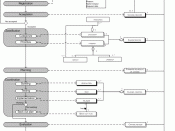Defend the statement: In therapy, clients should engage in small problem-managing behaviors right from the beginning. This is a powerfuly insightful statement that is a tough defense against therapy failure. As we have read in our text throughout this course, action is the underlying current that flows through all the steps and stages of the helping process. Therapy is about change, not dwelling in problems, therefore helpers shouuld always be focusing on ways to start the change process (Egan, 1998). Change is difficult. Clients come into therapy wanting change and seeing change, even little pieces of it, would have to build commitment to therapy. Plans that are divided down into subgoals and small steps build discpline and confidence (Egan, 1998). Modeling is listed as one of the effective frameworks for effective change and growth. If the clients see the helpers coming up ideas and small plans right away the client is more likely to get excited about change and decide to act like the therapist.
The difficulty of change and all the possible set-backs are yet another reason why clients should engage in small problem-managing behavior right away. There are obstacles along every path the client will choose. James Prochaska and Carlo Diclemente (1982) (as cited by Westermeyer, 1999) developed a model of change that specifically adresses these two important concerns. They see eight stages to change. The first is Precontemplation. This is when others notice the problem, but the client has no sense that there is a problem. The second is contemplation. Something happens and gets you to see there is a problem. This is where set-backs start in the change process. Once you see a problem in your life, it is natural for the strengths and positve things about the problem to act as setbacks to early change.


